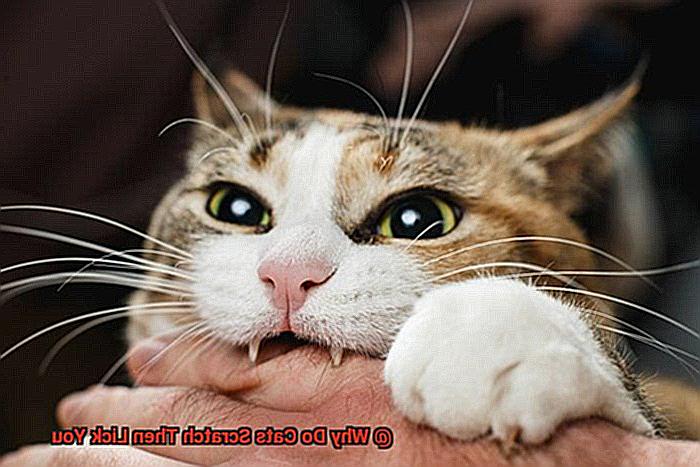Cats have a way of leaving us in awe with their peculiar habits and idiosyncrasies. One such habit that often leaves cat owners scratching their heads (pun intended) is the strange behavior of scratching then licking you. As a cat parent, you’ve probably experienced this phenomenon firsthand – you’re petting your feline friend, and all of a sudden, they whip out their claws and give you a few scratches before showering you with affectionate licks.
But what does it all mean? Is it a sign of love or something more sinister? Fear not, dear reader. In this blog post, we’ll delve into the reasons why cats scratch then lick you and explore the possible explanations behind this curious behavior.
From the science behind scratching to the art of grooming, we’ll take an in-depth look at every aspect of feline behavior that could shed some light on this mystery. Whether you’re an experienced cat owner or just a curious observer, our exploration will reveal fascinating insights into your furry friend’s psyche.
So sit back, grab your favorite beverage, and get ready to discover why cats scratch then lick you – once and for all.
What is Scratching and Licking?
Scratching and licking may seem like peculiar behaviors to us humans, but they are completely normal for cats. Scratching involves using their sharp claws to scratch surfaces, while licking involves using their rough tongues to groom themselves or other animals. These behaviors serve various purposes and understanding them can help cat owners provide appropriate outlets for their furry friends.
Scratching is a natural behavior for cats that helps them shed their old claws, stretch their muscles, and mark their territory. By leaving visual and scent marks on surfaces, cats communicate to other animals that the area is theirs. Additionally, scratching helps cats keep their claws sharp and healthy. Providing appropriate scratching surfaces such as scratching posts or cardboard boxes can help prevent damage to furniture while promoting healthy behavior in cats.
Licking is another natural behavior for cats that serves several purposes. Cats use their tongues to groom themselves and keep their fur clean and tangle-free. They also lick other animals as a sign of affection or submission. Furthermore, licking releases endorphins in cats, which can help them cope with stress or anxiety. Spending quality time with your cat through playtime and grooming can help reduce stress and anxiety in your furry friend.
It is not uncommon for cats to exhibit both scratching and licking behaviors in quick succession. This behavior can often be observed when a cat is feeling content or relaxed. However, excessive scratching or licking could be a sign of stress or anxiety in cats. Understanding these behaviors can help cat owners provide appropriate outlets for their furry friends and promote healthy behavior.
Marking Territory
It’s important to remember that these behaviors play a crucial role in a cat’s life, as they are natural ways of marking their territory.
Let’s take a closer look at how cats use scratching and licking to assert their ownership.
- Scratching: When cats scratch objects or people, they’re leaving behind both visible and scent cues. Cats possess scent glands in their paws, and by scratching, they deposit unique pheromones that act as a form of communication with other cats. Essentially, they’re saying, “This is mine.” Therefore, when your cat scratches your furniture or carpet, they’re not being destructive; they’re just marking their territory.
- Licking: Another way cats mark their territory is through licking. When a cat licks an object or person, they’re leaving behind their scent. Cats have scent glands in their mouths, and the saliva they deposit carries unique pheromones that identify them as the owner of that object.

It’s essential to realize that scratching and licking aren’t always indicators of aggression or dominance. In fact, these behaviors can be a way for cats to bond with their owners. When your cat rubs against you or licks you, it’s a way for them to claim you as part of their territory while also expressing affection.
However, excessive scratching or destructive behavior can be a sign of boredom or anxiety. To prevent this behavior, provide your cat with appropriate scratching posts and toys to redirect their attention. Also, ensure that your cat receives enough mental stimulation and physical exercise to remain happy and healthy.
Seeking Comfort and Reassurance
Cats possess distinct personalities and idiosyncrasies that often leave us befuddled. However, one thing is for sure, they show affection, seek comfort and reassure their humans in their own unique way.
If you have ever experienced your cat scratching and licking you, then you know the feeling of their love and comfort. It might seem like an unusual behavior at first, but it is their way of expressing their love and seeking comfort from you. Let’s delve into the reasons why cats scratch and lick their owners.
Scratching is a natural behavior for cats and serves multiple purposes. It helps them remove the dead outer layer of their claws, stretch their muscles, and mark their territory. However, scratching could also indicate stress or anxiety. When a cat scratches you, it could be a way for them to release pent-up energy or frustration. Therefore, providing your cat with plenty of toys and scratching posts is essential to prevent destructive behavior.
Licking is another way cats demonstrate affection and care. It is a grooming behavior that they use to regulate their body temperature and clean themselves. When your cat licks you, they are conveying trust and love. Therefore, when your cat licks you, it’s important to respond with positive reinforcement and affection.
To strengthen the bond between you and your furry friend, responding with love and positive reinforcement is crucial whether your cat is scratching or licking you. Additionally, providing your cat with plenty of toys, scratching posts, and mental stimulation can help prevent destructive behavior.
Communication and Playtime
Cats may seem mysterious, but they have their own ways of telling you what they need.
Scratching is one way that cats communicate with their owners. It helps them mark their territory, stretch their muscles, and relieve stress. If your cat scratches you, it might be a sign that they’re claiming you as their own or trying to release some tension. But don’t worry, it’s not personal.
Another way cats communicate is through licking. When your cat licks you, it’s usually a sign of affection and grooming. Licking also releases feel-good hormones in cats, which can help them relax and bond with you.
Playtime is just as important for your cat’s well-being. It helps them burn off energy, exercise their muscles, and improve their coordination. Plus, playing with your cat is a great way to strengthen your bond and build trust.
However, it’s essential to understand your cat’s behavior during playtime. If they scratch you excessively or become overstimulated, it’s time to take a break and give them some space to calm down. Providing appropriate toys and scratching posts can also help redirect destructive scratching behavior.
Signs of Affection
One of the most common actions that can leave you scratching your head is when your cat scratches and licks you. But fear not, as this action is actually a sign of affection from your feline companion.
Scratching is a natural behavior for cats. It helps them mark their territory and maintain healthy claws. When a cat scratches you, it’s likely that they are trying to mark you as their territory or show that you are an important figure in their life. Don’t worry though, this behavior is not meant to harm or hurt you in any way.
On the other hand, grooming is a crucial aspect of a cat’s life. When cats groom each other, they are strengthening their bond and showing affection. So, when your cat licks you, it could be trying to groom you as a way to express its love and affection towards you.
It’s important to remember that some cats may scratch and lick as a form of play. This behavior often involves gentle nibbling and is not intended to cause any harm or discomfort. However, it’s essential to keep an eye on your cat’s behavior during playtime and ensure that it doesn’t become too rough or aggressive.
Stress and Anxiety
While you may believe that it’s just a way of showing affection, these behaviors could be signs of your pet’s stress and anxiety. Yes, just like humans, cats can experience stress and anxiety, and it’s crucial to understand the reasons behind their behavior.
Changes in their environment, such as moving to a new home or the introduction of a new pet, can be common stressors for cats. Similarly, if they are not getting enough attention or feel threatened by other animals or people, it can lead to anxiety. As an expert on stress and anxiety in cats, I can tell you that these feelings can manifest in various ways.
Scratching is a natural behavior for cats, but when they’re stressed or anxious, they may scratch more frequently and aggressively. This helps them release pent-up energy and frustration. After scratching, cats may lick themselves or their owners as a form of self-soothing. Licking releases endorphins in the brain, which can help reduce stress and anxiety. It’s a grooming behavior that helps cats relax and feel more comfortable.
To alleviate their stress levels, it’s essential to recognize the signs of stress and anxiety in your cat and take steps to make them feel safe and comfortable. Providing a safe environment, spending quality time with your cat, and offering toys and scratching posts are excellent ways to reduce their stress levels. If the behavior persists despite your efforts, it may be necessary to consult with a veterinarian or animal behaviorist for further guidance.
Changes in Routine or Environment
While it may seem like a sign of affection, it could actually be a result of stress and anxiety caused by changes in routine or environment. As creatures of habit, cats are highly sensitive to any changes in their daily routine or living environment. This can range from something as simple as rearranging furniture to something as significant as moving to a new home or introducing a new pet to the household.
Changes in routine or environment can leave cats feeling uneasy, which can lead to excessive scratching and licking. Scratching is a natural behavior for cats, but when they do it excessively, it’s usually a coping mechanism for stress. It helps relieve tension in their muscles and releases pent-up energy. Licking, on the other hand, has a calming effect on their nervous system.
In some cases, cats may also use scratching and licking to mark their territory when there are changes in the household. They may feel the need to reassert their dominance by marking their owners with their scent.
To help alleviate stress and anxiety in cats during times of change, it’s crucial to maintain consistency in their routine as much as possible. Here are some tips that can help:
Stick to regular feeding times – Cats thrive on routine and structure, so maintaining a consistent feeding schedule can help them feel more secure.
Provide plenty of playtime and exercise – Playtime is not just fun for cats; it’s also an essential part of their physical and mental wellbeing. Regular exercise can help them release pent-up energy and reduce stress.
Create a comfortable and familiar space for your cat – Providing your cat with a designated space that they can call their own can help them feel more secure during times of change.
Give them attention and affection – During times of change, it’s important to give your cat plenty of attention and affection to reassure them that they are still loved and valued members of the family.
Prevention Tips for Cat Owners
To prevent this from happening, cat owners can take certain steps to minimize the scratching behavior of their pets. Here are five prevention tips for cat owners:
Trim Your Cat’s Claws Regularly
One of the easiest ways to prevent your cat from scratching you is to keep their claws trimmed. Regular claw trimming can help prevent injuries to both you and your cat. A good rule of thumb is to trim your pet’s claws every two weeks. You can either do this yourself using nail clippers or take them to a groomer.
Provide Your Cat with Scratching Posts
Cats love to scratch, and providing them with a dedicated scratching post can help redirect their scratching behavior away from furniture and other household items. Make sure the post is tall enough for your cat to stretch out fully and sturdy enough so it won’t tip over. You can also place the post near areas where your cat likes to scratch.
Use Positive Reinforcement
Reward your cat with treats or praise when they use their scratching post instead of other items in the house. This will encourage them to continue using the post and discourage them from scratching other items. Positive reinforcement is an effective way to train your cat and reinforce good behavior.
Deter Unwanted Scratching Behavior
You can use deterrents like double-sided tape or aluminum foil on furniture or other items to discourage your cat from scratching them. These materials feel uncomfortable on cats’ paws, making them less likely to scratch the area. You can also use a spray bottle filled with water to discourage unwanted behavior.
Provide Mental and Physical Stimulation
Boredom and lack of exercise can lead to excessive scratching behavior in cats. Providing toys and interactive playtime can help keep them mentally and physically stimulated. This will also help prevent other unwanted behaviors such as excessive meowing or destructive chewing. You can also provide your cat with puzzle feeders or hide treats around the house to encourage them to explore and play.
Conclusion
In conclusion, the curious behavior of cats scratching and then licking their owners is a natural way for them to communicate and bond with their humans. Scratching is a primal instinct that assists felines in shedding old claws, stretching their muscles, and marking their territory. On the other hand, licking serves several purposes such as grooming themselves or other animals, showing affection, and releasing endorphins to cope with stress or anxiety.
While these behaviors are typically signs of love and devotion from your feline companion, excessive scratching or licking may indicate stress or anxiety in cats. Understanding your cat’s behavior during playtime and providing appropriate toys and scratching posts can help redirect destructive scratching behavior.
Alterations in routine or environment can also trigger stress and anxiety in cats, leading to excessive scratching or licking. Maintaining consistency in their routine as much as possible can help alleviate stress levels during times of change.
As cat owners, we can take certain measures to prevent unwanted scratching behavior by trimming our cat’s claws regularly, providing them with dedicated scratching posts, using positive reinforcement techniques, implementing deterrents on furniture or other items, and providing mental and physical stimulation through playtime.
In summary, comprehending our furry friend’s behaviors can assist us in providing suitable outlets for them while strengthening our bond with them.







